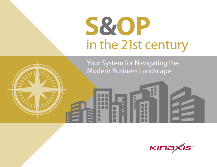In a previous post, I talked about the ineffectiveness of Excel, ERP, and legacy planning for S&OP. If those aren’t the right tools for the job, what is? I heard a colleague once give the following analogy: Imagine a pilot flying from New York to Los Angeles at night without any navigation systems or instruments to measure his location, wind speed, or altitude. Instead, every two hours he checks the stars with a sextant, extracts data from the flight recorder about his throttle settings, and draws in the plane’s likely location on a map. What are the chances of that pilot actually getting to LA? Can he arrive on any predictable timetable? You’ll likely agree his chances are slim to none. A modern pilot embarks with a general flight plan, but then monitors a continuous readout of key metrics, which he uses to make numerous small course corrections to arrive at the proper destination on schedule. It’s the same for business. Successful S&OP provides a navigation system to help determine where you are going, where you have been, when you are off course, and how to get back on course. The four keys to highly effective S&OP are:
- East-West integration - bringing together demand and supply planning
- North-South integration - bringing together Finance and Operations
- Tying together volume and mix plans
- S&OP on-demand, not only on-schedule
With this model of S&OP, process execution evolves into operational orchestration, efficiency goals are coupled with measures of effectiveness, and cost control objectives are appropriately balanced with mandates for delivering business performance and value-based outcomes. In this post, I’ll tackle the first two keys and I’ll follow-up with a second blog post for the latter two.
KEY #1 East-West Integration: Demand + Supply
Too many companies develop and manage separate demand plans and supply plans in isolation, only coming together with an aggregate or volume plan during the S&OP meeting. Ideally, all plans should be developed in the same system, and encompass all the operational details that fall under the high-level summaries. Many call this “east-west integration” to suggest how it brings two points of the compass together. Executives know this integration of demand and supply is vital to gain: Cross-enterprise view Having more data from contract manufacturers and parts suppliers integrated in one central place gives you a comprehensive view of your extended supply chain. Cross-functional view When you can see across and deep within the traditional silos of demand and supply planning, you gain better insight into what’s really going on and what’s feasible going forward. Better, faster plans Demand and supply integration supports more accurate plans, faster planning cycles, clearer insights, and better collaboration. Better decision support When demand and supply planning are brought together, testing the feasibility of high-level plans and reconciling planning to execution are faster and easier for everyone.
Key #2 North-South Integration: Finance + Operations
Bringing Finance into the S&OP process in a meaningful way is referred to as “north-south” alignment. Unfortunately, this doesn’t always happen. In too many cases, Finance simply rubber-stamps or files away plans developed without their input. S&OP gives Finance an opportunity to evaluate, monitor, and influence the financial impact of the plan. Finance should play an active role in setting targets and ensuring operational plans are aligned with corporate objectives. As teams are developing plans and responding to events, they should be looking at the alternatives and consider the potential financial impacts by asking:
- What will it do to profitability?
- What will it do to market share?
- Can I accomplish it with my resources?
- Are the risks worth it?
These questions all have significant financial considerations, yet there is a disconnect between Operations and Finance in most S&OP processes that make projecting what the impact decisions will have on financial metrics exceptionally difficult, or at the very least, ineffectually slow. Linking financial metrics (such as revenue, margin, and cash flow) to operational metrics (such as orders delivered on-time and in-full, inventory turns, and capacity utilization) gives you a way to check if your operational decisions are consistent with your financial objective. This also helps you see if your financial objectives are achievable. As I mentioned above, in my next blog post, I’ll take a look at the remaining two keys to S&OP effectiveness:
- Tying volume and mix plan together
- S&OP on demand, not only on schedule
| S&OP in the 21st CenturyAs the S&OP process continues to evolve and mature, a different interpretation and expectation for S&OP is emerging that entails better, broader goals. This recently published eBook elaborates on the evolving horizontal S&OP process capabilities that are required in order to achieve a transformation. Download your own copy here. |
Additional Resources
- S&OP frequently asked questions






Leave a Reply